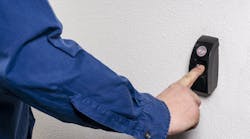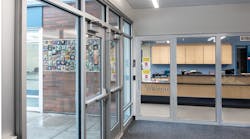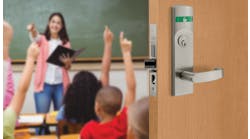The massacre last year of students and teachers inside Sandy Hook Elementary School in Newtown, Conn., has prompted school systems throughout the nation to re-assess how effectively the doors in their facilities are able to keep intruders out and protect those inside.
Although upgrading school doors won’t necessarily prevent a determined intruder from getting inside a facility, installing equipment that hinders or delays an intrusion may dissuade someone from carrying out an attack or give emergency responders enough time to disrupt it.
Since the Columbine High School shooting attack in 1999, schools have been more diligent about determining who may enter a facility. The National Center for Education Statistics’ Indicators of School Crime and Safety says that in 2009-10, 91.7 percent of public schools controlled access to their buildings through locked or monitored doors. In 1999-2000, 74.6 percent of schools did so.
In recent years, more focus is being put on providing classroom doors that can be locked from the inside to protect teachers and their students from intruders who may have entered the building and are looking for potential victims.
In California, a law that went into effect in 2011 requires that new K-12 school construction projects that receive state funding “shall include locks that allow doors to classrooms and any room with an occupancy of five or more persons to be locked from the inside.” The law exempts doors to student restrooms and doors that are locked from the outside at all times (examples include storage rooms, janitor’s closets and boiler rooms).
The new requirement for doors does not change the existing provision that classroom doors must be “readily openable from the egress side without the use of a key or special knowledge or effort.”
In the aftermath of the Sandy Hook attack, a report from the Connecticut General Assembly’s Office of Legislative Research found that many districts in the state have taken actions to improve door security on their campuses, including interior locks on classroom doors. Other measures:
•Installing new mechanisms, such as automatic locks, swipe-card access systems, buzz-in intercoms, panic buttons, surveillance cameras and sally ports (an entry way with multiple sets of doors that creates a locked vestibule).
•Putting alarms on school doors that are not used for entry.
•Installing annunciator panels that provide visual or audible warnings when a exterior door has been left open.
•Replacing a key-card entry system for staff member with a biometric system that uses finger scanning.
•Installing bullet-resistant film on exterior doors.
Less life-threatening than an armed intruder, but more likely to occur at an education facility is vandalism. To deter someone from breaking into a school, exterior doors should have as little exposed hardware as possible, and their hinges should have non-removable pins, according an assessment guide for schools compiled by the National Clearinghouse for Educational Facilities.
Exterior doors used only for exiting a building do not need handles or locks protruding on the outside, the guide says, but there should be a way, such as a proximity card, to open the door from the outside in an emergency.
Panic bar latches on exterior doors should have pick plates that prevent intruders from using tools or plastic bars to release the bolt, the guide says.
Kennedy is staff writer for AS&U.


